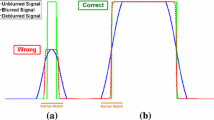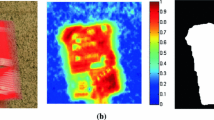Abstract
The present research is organized with a focus on a block-based algorithm to estimate the image noise variance in the blurred images, in order to be applicable in the area of motion deblurring approach. The main problem in estimating the image noise variance through traditional available applications is the loss of real edge lines in the process of creating smooth areas. This complicated point is considered in the present research to be solved through double-side edge lines for the purpose of identifying the potential smooth areas. The blind algorithm presented here finds large rectangles around each end-side of edge lines. This utilizes the statistical measures to estimate the noise variance in the selected areas. It should be noted that the most important difference between the approach presented here and the available literatures, is its usage in case of blind algorithm and also the low computational complexity. It assists us to present a real-time application, in one such case. The results show that the algorithm estimates the noise variances, successfully, based on a number of standard images by developing the motion deblurring approach. Afterwards, in line with the results of the image noise variance estimation, the motion deblurring approach has been designed to retrieve the original version of the blurred and noisy image, which is under the influence of uniform linear motion with constant velocity. In order to consider the effectiveness of the proposed approach, the outcomes regarding some comparison criteria including the peak signal to noise ratio, the structural similarity, the computational complexity and finally the size of processed images have been compared with those obtained from the well-known linear motion approaches, as the potential benchmarks.













Similar content being viewed by others
References
AlZoubi O, Fossati D, D’Mello S, Calvo RA (2014) Affect detection from non-stationary physiological data using ensemble classifiers. Evol Syst (in press)
Bates R (1982) Astronomical speckle imaging. Psy Rep 90:97–203
Ben-Ezra M, Nayar S (2003) Motion deblurring using hybrid imaging. IEEE Computer Society Conference on Computer Vision and Pattern Recognition :8–16
Ben-Ezra M, Nayar SK (2003) Motion deblurring using hybrid imaging. Computer Vision and Pattern Recognition, Proceedings IEEE Computer Society Conference on, vol 1, pp I-657–I-664
Ben-Ezra M, Nayar S (2004) Motion based motion deblurring. IEEE Trans Pattern Anal Mach Intell 26:689–699
Benmazou S, Merouani HF, Layachi S, Nedjmeddine B (2014) Classification of mammography images based on cellular automata and Haralick parameters. Evolving Syst 5(3):209–216 (Springer Publisher)
Bovik A (ed) (2006) Handbook of Image and Video Processing, 2nd edition, Elsevier, Beijing
Donoho DL (1995) Denoising By soft Thersholding. IEEE Trans Inf Theory 41:613–627
Gonzalez RC, Woods RE (2002) Digital image processing, Second Edition: USA: Prentice-Hall
Hashemi M, Beheshti S (2010a) Adaptive noise variance estimation in Bayesshrink. IEEE Signal Process Lett 17(1):12–15
Hashemi M, Beheshti S (2010b) Adaptive noise variance estimation in Bayesshrink. IEEE Signal Process Lett 17(1):12–15
He WG (2010) Estimation of the noise variance of uniform linear motion the blurred images. In: Informatics in Control, Automation and Robotics (CAR), 2nd International Asia Conference on, vol 3, pp 64–67
He Ning, Ke Lu, Bing-Kun Bao Lu-Lu, Zhang Jin-Bao Wang (2014) Single-image motion deblurring using an adaptive image prior. Inf Sci 281:736–749
Huang D, Fujiyama N, Sugimoto S (2002) A DST-based maximum likelihood parameter identification and restoration method for noisy the blurred image. In: Signal Processing, 2002 6th International Conference on vol 1, pp 869–872
Huang D, Fujiyama N, Sugimoto S (2002) A DST-based maximum likelihood parameter identification and restoration method for noisy the blurred image. In: Signal Processing, 6th International Conference on, vol 1, pp 869–872
Kazemzadeh R (2009) An optimal approach for image motion deblurring based on PSF estimation, CSICC
Kim Bongjoe, Choi Jihoon, Park Yongwoon (2012) Robust corner detection based on image structure. Circuits Syst Signal Process 31(4):1443–1457 (Springer Publisher)
Kundur (1995) Blind deconvolution of still images using recursive inverse filtering, M.Sc. Thesis in Applied Sciences and Engineering, Toronto
Kundur D, Hatzinakos D (1996) Blind image deconvolution. IEEE Signal Process Mag 13:43–64
Lagendijk RL, et al. (1990) Identification and restoration of noisy the blurred images using the expectation-maximization algorithm. IEEE Trans Acoust Speech Signal Process 38
Levin A (2006) Blind motion deblurring using image statistics. The Hebrew University of Jerusalem
Li Haisen, Zhang Yanning, Sun Jinqiu (2015) Motion deblurring using the similarity of the multiscales. Opt Int J Light Electron Opt 126(4):473–477
Liu C, Szeliski R, Kang SB, Zitnick CL, Freeman WT (2008) Automatic (2008) Estimation and removal of noise from a single image. Pattern Anal Mach Intell IEEE Trans 30(2):299–314
Liu C, Szeliski R, Kang SB, Zitnick CL, Freeman WT (2008b) Automatic estimation and removal of noise from a single image. IEEE Trans Pattern Anal Mach Intell 30(2):299–314
Loyev V, Yitzhaky Y (2006) Initialization of iterative parametrics algorithms for blind deconvolution of motion the blurred images. Appl Optics 45:2444–2452
McCallum BC (1990) Blind deconvolution by simulated annealing. Optics Commun 75:101–105
Mignotte M, Meunier J (2000) A comparison of supervised and blind deconvolution techniques. IEEE Trans Biomed Eng 47
Moghaddam ME (2006a) Motion blur identification in noisy images using feed-forward back propagation neural networks. Springer, Berlin Heidelberg, pp 369–376
Moghaddam ME (2006) Motion blur parameter estimation. PhD Thesis, Computer Engineering, Sharif University of Technology, Tehran
Moghaddam ME (2010) Linear Motion blur identification in noisy images using bispectrum and feed forward back propagation neural networks. Int J Pattern Recognit Artif Intell (IJPRAI) 24:281–302
Moghaddam ME, Jamzad M (2004) Finding point spread function of motion blur using Radon transform and modeling the motion length, Signal Processing and Information Technology. In: Proceedings of the Fourth IEEE International Symposium on, pp 314–317
Moghaddam ME, Jamzad M (2005) Motion blur identification in noisy images using fuzzy sets. In: Signal Processing and Information Technology, Proceedings of the Fifth IEEE International Symposium on, pp 862–866
Moghaddam ME, Jamzad M (2007) Motion blur identification in noisy images using mathematical models and statistical measures. J Pattern Recognit 40:1946–1957
Nguyen TM, Wu QMJ (2013) A fuzzy logic model based Markov random field for medical image segmentation. Evol Syst 4(3):171–181 (Springer Publisher)
Pei Z, Tong Q, Wang L, Zhang J (2010) A median filter method for image noise variance estimation. Inform Technol Computer Sci (ITCS), Second International Conference on :13–16
Pei Z, Tong Q, Wang L, Zhang J (2010) A median filter method for image noise variance estimation. In: Information Technology and Computer Science (ITCS), 2010 Second International Conference on, pp 13–16
Ramadan Zayed M (2013) Monochromatic-based method for impulse noise detection and suppression in color images. Circuits Syst Signal Process 32(4):1859–1874 (Springer Publisher)
Sahraeian ME (2007) Noise removal using wavelet transform, M.Sc. Thesis, Khaje-Nasir Toosi University, Tehran
Schmidt U, Schelten K, Roth S (2011) Bayesian deblurring with integrated noise estimation. Computer Vision and Pattern Recognition (CVPR), IEEE Conference on :2625–2632, 20–25
Schmidt U, Schelten K, Roth S (2011) Bayesian deblurring with integrated noise estimation. In: Computer Vision and Pattern Recognition (CVPR), 2011 IEEE Conference on, pp 2625–2632
Wan Y, Chen Q, Yang Y (2010a) Robust impulse noise variance estimation based on image histogram. IEEE Signal Process Lett 17(5):485–488
Wan Yi, Chen Qiqiang, Yang Yan (2010b) Robust Impulse Noise Variance Estimation Based on Image Histogram. IEEE Signal Process Lett 17(5):485–488
Wei-Guo He (2010) Estimation of the noise variance of uniform linear motion the blurred images. In: Informatics in Control, Automation and Robotics (CAR), 2010 2nd International Asia Conference on vol 3, pp 64–67
Wiggings RA (1978) Minimum energy deconvolution. Geoexploration 16:21–35
Wu S (2007) Blind Image Blur Identification in Cepstrum Domain. In: Proceedings of 16th International Conference on Computer Communications and Network, pp 1166–1171
Koloda J, Sánchez V, Spatial error concealment based on edge visual clearness for image/video communication. Circuits Syst Signal Process 32(2):815-824 (Springer Publisher)
Yitzhaky Y (1999) Comparison of direct blind decovolution methods for motion the blurred images. Appl Optics 38:4325–4332
Author information
Authors and Affiliations
Corresponding author
Rights and permissions
About this article
Cite this article
Mazinan, A.H., Karimi, A. Block-based noise variance estimation algorithm in blurred and noisy images with its application to motion deblurring. Evolving Systems 8, 95–108 (2017). https://doi.org/10.1007/s12530-015-9134-4
Received:
Accepted:
Published:
Issue Date:
DOI: https://doi.org/10.1007/s12530-015-9134-4




